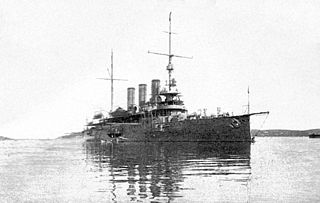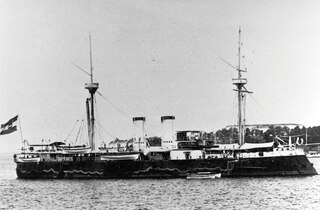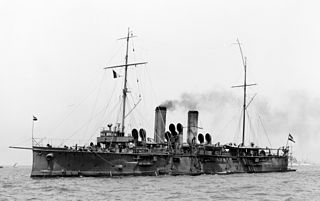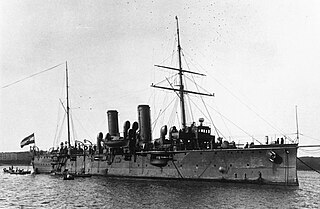
SMS Sankt Georg was the third and final armored cruiser of the Austro-Hungarian Navy. She was built at the Pola Arsenal; her keel was laid in March 1901, she was launched in December 1903, and completed in July 1905. Her design was based on the previous armored cruiser Kaiser Karl VI, with the primary improvement being a stronger armament. Sankt Georg, named for Saint George, was armed with a main battery of two 24-centimeter (9.4 in) guns, five 19 cm (7.5 in) guns, and four 15 cm (5.9 in) guns.

SMS Kaiserin und Königin Maria Theresia was an armored cruiser used by the imperial Austro-Hungarian Navy from 1895 to 1917; she was the first ship of that type built by the Austro-Hungarian Navy. The ship was a unique design, built by the Stabilimento Tecnico Triestino shipyard in Trieste; she was laid down in July 1891, launched in April 1893, and completed in November 1894. Armed with a main battery of two 24-centimeter (9.4 in) guns and eight 15 cm (5.9 in) guns, the ship provided the basis for two subsequent armored cruiser designs for the Austro-Hungarian Navy.

SMS Panther was a torpedo cruiser (Torpedoschiff) of the Austro-Hungarian Navy. She and her sister ship, Leopard were part of a program to build up Austria-Hungary's fleet of torpedo craft in the 1880s. She was the lead ship of her class, and was built in Britain by Armstrong, from her keel laying in October 1884 to her completion in December 1885. She was armed with a battery of two 12 cm (4.7 in) guns and ten 47 mm (1.9 in) guns, along with four 356 mm (14 in) torpedo tubes.

SMS Leopard was a torpedo cruiser (Torpedoschiff) of the Austro-Hungarian Navy. She and her sister ship, SMS Panther, were part of a program to build up Austria-Hungary's fleet of torpedo craft in the 1880s. Both ships, the only members of the Panther class, were built in Britain at the Armstrong shipyard in Elswick. Leopard was laid down in January 1885, launched in September 1885, and completed in March 1886. She was armed with a battery of two 12 cm (4.7 in) guns and ten 47 mm (1.9 in) guns, along with four 356 mm (14 in) torpedo tubes.

SMS Lussin was a torpedo cruiser of the Austro-Hungarian Navy, a modified version of the preceding Zara class. As envisaged by the Marinekommandant, Vice Admiral Friedrich von Pöck, Lussin would be the leader of a flotilla of torpedo boats, with the additional capability of carrying out scouting duties. The ship proved to be too slow and too lightly armed for either of these tasks, so she spent the majority of her career as a training ship for engine and boiler room personnel, along with occasional stints with the main fleet for training exercises. She took part in only one significant operation, an international blockade of Greece in 1886 to prevent the country from declaring war on the Ottoman Empire. In 1910–1913, Lussin was rebuilt as an admiralty yacht, and she spent World War I as a barracks ship for German U-boat crews based in Pola. After the war, she was ceded to Italy as a war prize, renamed Sorrento, and briefly saw service as a mother ship for MAS boats from 1924 to 1928, when she was discarded.

SMS Kaiser Karl VI was the second of three armored cruisers built by the Austro-Hungarian Navy. She was built by the Stabilimento Tecnico Triestino in Trieste between June 1896 and May 1900, when she was commissioned into the fleet. Kaiser Karl VI represented a significant improvement over the preceding design—Kaiserin und Königin Maria Theresia—being faster and more heavily armed and armored. She provided the basis for the third design, Sankt Georg, which featured further incremental improvements. Having no overseas colonies to patrol, Austria-Hungary built the ship solely to reinforce its battle fleet.

SMS Kronprinzessin Erzherzogin Stephanie was an ironclad warship built for the Austro-Hungarian Navy in the 1880s, the last vessel of that type to be built for Austria-Hungary. The ship, named for Archduchess Stephanie, Crown Princess of Austria, was laid down in November 1884, was launched in April 1887 and completed in July 1889. She was armed with a pair of 30.5-centimeter (12 in) guns in open barbettes and had a top speed of 17 knots. Her service was limited, in large part due to the rapid pace of naval development in the 1890s, which quickly rendered her obsolescent. As a result, her career was generally limited to routine training and the occasional visit to foreign countries. In 1897, she took part in an international naval demonstration to force a compromise over Greek and Ottoman claims to the island of Crete. Kronprinzessin Erzherzogin Stephanie was decommissioned in 1905, hulked in 1910, and converted into a barracks ship in 1914. After Austria-Hungary's defeat in World War I, the ship was transferred to Italy as a war prize and was eventually broken up for scrap in 1926.

SMS Don Juan d'Austria was an ironclad warship built for the Austro-Hungarian Navy in the 1870s, the second of the three ships of the Kaiser Max class. The ship was purportedly the same vessel that had been laid down in 1861, and had simply been reconstructed. This was a fiction, however; the head of the Austro-Hungarian Navy could not secure funding for new ships, but reconstruction projects were uncontroversial, so he "rebuilt" the three earlier Kaiser Max-class ironclads. Only the engines and parts of the armor plate were reused in the new Don Juan d'Austria, which was laid down in February 1874, launched in December 1875, and commissioned in October 1876. The ship's career was fairly limited, in part due to slender naval budgets that prevented much active use. She made foreign visits and took part in limited training exercises in the 1880s and 1890s. Long since obsolete, Don Juan d'Austria was removed from service in 1904 and used as a barracks ship through World War I. After the war, she sank under unclear circumstances.

SMS Custoza was an ironclad warship built for the Austro-Hungarian Navy in the 1870s, the only member of her class. She was the first Austro-Hungarian ironclad to be built after the navy studied the results of the Battle of Lissa of 1866; she was also the first iron-hulled capital ship to be built for the Austro-Hungarian Navy. She was laid down in November 1869, launched in August 1872, and completed in February 1875. Her career was fairly limited, in part due to reduced naval budgets in the 1870s that also delayed her completion. Custoza was somewhat more active in the 1880s, taking part in an international naval demonstration against the Ottoman Empire in 1880, being modernized in 1882, and a trip to Spain for the Barcelona Universal Exposition in 1888. The ship became a training ship in 1902, was converted into a barracks ship in 1914, and after World War I, was awarded as a war prize to Italy. Custoza was immediately broken up.

SMS Lissa, named for the Battle of Lissa, was a unique ironclad warship built for the Austro-Hungarian Navy in the 1860s and 1870s, the only member of her class. She was the first casemate ship built for Austria-Hungary, she was armed with a main battery of twelve 9-inch (229 mm) guns in a central armored casemate, unlike the earlier broadside ironclads. Construction of the ship lasted from June 1867 to May 1871, and was delayed by budgetary shortfalls; the lack of funding also plagued the ship during her career, preventing her from taking an active role in the fleet. She spent the majority of her time in service laid up in Pola, apart from a lengthy reconstruction in 1880–1881. Lissa was ultimately stricken from the fleet in 1892 and broken up for scrap starting the following year.

The Panther-class was a group of two torpedo cruisers, Panther and Leopard, built for the Austro-Hungarian Navy in the 1880s. The ships' primary armament was their four torpedo tubes, though they also carried a battery of medium and light-caliber guns. The ships were ordered in an effort to strengthen the defensive capabilities of the Austro-Hungarian Navy, during a period where funding for more expensive ironclad warships could not be secured from parliament. Since Austro-Hungarian naval designers did not have sufficient experience designing vessels of the type, the navy ordered the ships from the British Armstrong shipyard; work took from late 1884 to early 1886. After arriving in Austria-Hungary in 1886, the two ships served in a variety of roles. These included active duty with the main fleet in home waters, overseas training cruises, and showing the flag abroad. During World War I, the cruisers were mobilized for coastal defense duties, but saw no major action, apart from Panther shelling Montenegrin forces in 1916. After the war, both vessels were surrendered to Britain as war prizes and were broken up for scrap in 1920.

SMS Zara was a torpedo cruiser of the Austro-Hungarian Navy, the lead ship of the Zara class. She was laid down in August 1878, launched in November 1879, and commissioned into the fleet in July 1882. The ship was armed with a battery of light guns and four torpedo tubes. She proved to be poorly designed, being too slow for use as a fleet scout or as a flotilla leader for torpedo boats, so she saw little active service. Throughout the 1880s and 1890s, she was frequently in reserve, being activated infrequently to participate in training exercises. She served as a guard ship in Cattaro Bay for most of World War I, before being withdrawn for use as a cadet training ship in June 1917. She served in this capacity until the end of the war in 1918, and was ceded to Italy as a war prize in 1920. The Italian Navy had no use for the vessel, and sold her to ship breakers in 1921.

SMS Spalato was a torpedo cruiser of the Austro-Hungarian Navy, the second member of the Zara class. She was laid down in September 1878, launched in August 1879, and commissioned in September 1881. Too slow to be used in her intended roles as a fleet scout and a flotilla leader, she was immediately taken ashore for several modifications to her propulsion system in an unsuccessful attempt to rectify the problem. As a result, she saw little active service, being used primarily for training purposes. She served in the artillery training school for most of the period between 1897 and 1914. During World War I, she served as a guard ship in Pola, and after the war was ceded to Italy as a war prize. She was broken up for scrap sometime thereafter.

SMS Sebenico was a torpedo cruiser of the Austro-Hungarian Navy, the third member of the Zara class, though built to a slightly different design to her two half-sister ships in an unsuccessful attempt to improve her speed. She was laid down in July 1880, launched in February 1882, and commissioned in December that year. Too slow to be used in her intended roles as a fleet scout and a flotilla leader, she saw little active service. She took part in an international naval demonstration off Crete in 1897, where she sank a Greek ship trying to break the blockade. Sebenico served as a training ship for the rest of her career, including with the artillery school from 1903 to 1915, and with the torpedo school until the end of World War I in 1918. Ceded to Italy as a war prize in 1920, she was then broken up for scrap.

The Zara class was a class of three torpedo cruisers built for the Austro-Hungarian Navy in the late 1870s and early 1880s; they were the first large torpedo-armed warships built by Austria-Hungary. The class comprised three ships, Zara, Spalato, and Sebenico; the last vessel was built to a slightly different design, and is sometimes not counted as a member of the class. The design was prepared by Josef von Romako, the Chief Constructor of the Austro-Hungarian Navy, after a lengthy design process throughout the 1870s. The first two ships were armed with deck-mounted torpedo tubes, while Sebenico received an experimental tube in her bow, submerged below the waterline.

SMS Aspern was the second of the three Zenta-class cruisers built for the Austro-Hungarian Navy in the 1890s. The class included two other vessels, Zenta and Szigetvár. The Zentas were intended to serve as fleet scouts and to guard the battleships against attacks by torpedo boats. They carried a main battery of eight 12 cm (4.7 in) guns manufactured by Škoda; Aspern and her sisters were the first major warships of the Austro-Hungarian fleet to be armed entirely with domestically produced guns. Unlike earlier Austro-Hungarian cruisers, the Zenta class discarded heavy belt armor in favor of a higher top speed.

SMS Szigetvár was a protected cruiser of the Zenta class, the third and final member of her class, which was built for the Austro-Hungarian Navy in the late 1890s. The class included two other vessels, Zenta and Aspern. The Zentas were intended to serve as fleet scouts and to guard the battleships against attacks by torpedo boats. They carried a main battery of eight 12 cm (4.7 in) guns manufactured by Škoda; Szigetvár and her sisters were the first major warships of the Austro-Hungarian fleet to be armed entirely with domestically produced guns. Unlike earlier Austro-Hungarian cruisers, the Zenta class discarded heavy belt armor in favor of a higher top speed.

The Zenta class was a group of three protected cruisers built for the Austro-Hungarian Navy in the 1890s.

SMS Tátra was the lead ship of her class of six destroyers built for the kaiserliche und königliche Kriegsmarine shortly before the First World War. Completed in 1913, she helped to sink an Italian destroyer during the action off Vieste in May 1915 after Italy declared war on Austria-Hungary. Two months later the ship participated in an unsuccessful attempt to recapture a small island in the Central Adriatic Sea from the Italians. In November and early December Tátra was one of the ships conducting raids off the Albanian coast to interdict the supply lines between Italy and Albania. During the early stages of the 1st Battle of Durazzo in late December, the ship was tasked to tow her one of her sister ships that had been crippled by a mine. She was forced to abandon her sister when the Austro-Hungarians were spotted by a strong force of Allied ships and had to evade their pursuit. Tátra participated in several unsuccessful raids on the Otranto Barrage in 1917. She was transferred to Italy in 1920 in accordance with the peace treaties ending the war and renamed Fasana. The Regia Marina used her for spare parts; she was discarded in 1923 and subsequently scrapped.



















